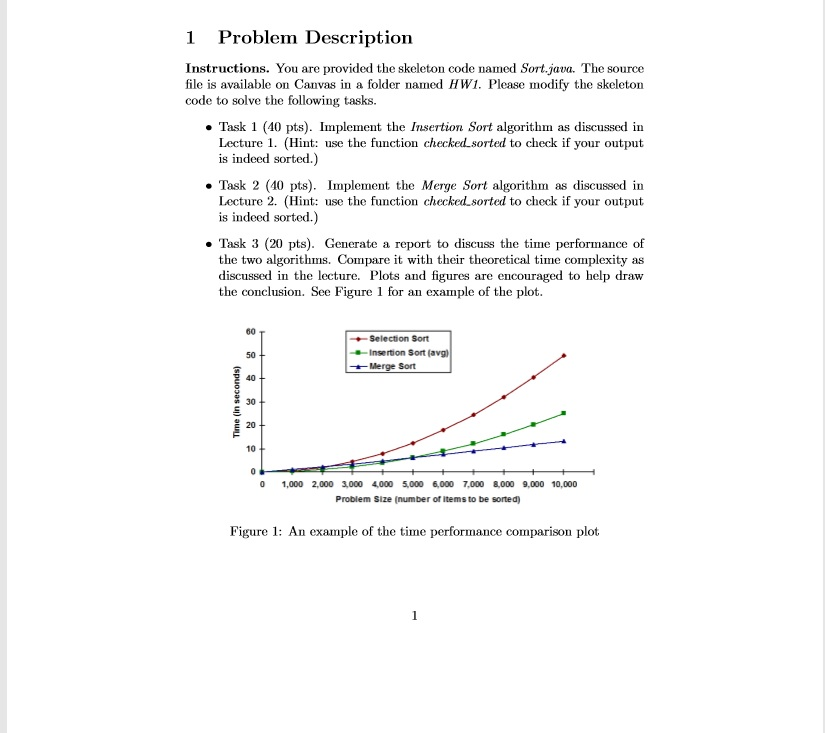Question
Here is the skeleton code import java.util.*; public class sort { public static int[] insertion_sort (int[] array) { /* * fill in your program */

Here is the skeleton code
import java.util.*;
public class sort {
public static int[] insertion_sort (int[] array) {
/* * fill in your program */
return array;
}
public static int[] merge_sort (int[] array, int p, int r) {
/* * fill in your program */
return array;
}
public static int[] merge (int[] array, int p, int q, int r)
{
/* * fill in your program */
return array;}
/*
* n: the size of the output array
* k: the maximum value in the array
*/
public static int[] generate_random_array (int n, int k) {
List
int[] array;
Random rnd;
rnd = new Random(System.currentTimeMillis());
list = new ArrayList
for (int i = 1; i
list.add(new Integer(rnd.nextInt(k+1)));
Collections.shuffle(list, rnd);
array = new int[n];
for (int i = 0; i
array[i] = list.get(i).intValue();
return array;
}
/*
* * n: the size of the output array
*/
public static int[] generate_random_array (int n) {
List
int[] array;
list = new ArrayList
for (int i = 1; i
list.add(new Integer(i));
Collections.shuffle(list, new
Random(System.currentTimeMillis()));
array = new int[n];
for (int i = 0; i
array[i] = list.get(i).intValue();
return array;}
/*
* Input: an integer array
* Output: true if the array is acsendingly sorted, otherwise return false
*/
public static boolean check_sorted (int[] array) {
for (int i = 1; i
if (array[i-1] > array[i])
return false;
}
return true;
}
public static void print_array (int[] array) {
for (int i = 0; i
System.out.print(array[i] + ", ");
System.out.println();
}
public static void main(String[] args) {
// TODO Auto-generated method stub
System.out.println("Insertion sort starts ------------------");
for (int n = 100000; n
int[] array = Sort.generate_random_array(n);
long t1 = System.currentTimeMillis();
array = Sort.insertion_sort(array);
long t2 = System.currentTimeMillis();
long t = t2 - t1;
boolean flag = Sort.check_sorted(array);
System.out.println(n + "," + t + "," + flag);
}
System.out.println("Insertion sort ends ------------------");
}
{
System.out.println("Merge sort starts ------------------");
for (int n = 100000; n
int[] array = Sort.generate_random_array(n);
//Sort.print_array(array);
long t1 = System.currentTimeMillis();
array = Sort.merge_sort(array, 0, n-1);
long t2 = System.currentTimeMillis();
long t = t2 - t1;//Sort.print_array(array);
boolean flag = Sort.check_sorted(array);
System.out.println(n + "," + t + "," + flag);
}
System.out.println("Merge sort ends ------------------");
}
}
1 Problem Description Instructions. You are provided the skeleton code named Sort.java. The source file is available on Canvas in a folder named HW1. Please modify the skeleton code to solve the following tasks . Task 1 (40 pts). Implement the Insertion Sort algorithm as discussed in Lecture 1. (Hint: use the function checked sorted to check if your output is indeed sorted.) . Task 2 (10 pts). Implement the Merge Sort algorithm as discussed in Lecture 2. (Hint: use the function checked sorted to check if your output is indeed sorted.) . Task 3 (20 pts). Generate a report to discuss the time performance of the two algorithms. Compare it with their theoretical time complexity as discussed in the lecture. Plots and figures are encouraged to help draw the conclusion. See Figure 1 for an example of the plot. 60 Selection Sort 50 -Insertion Sort (avg Merge Sort 40 30 20 10 0 1,000 2000 3,000 4000 5,000 6,000 7,000 8,000 9,000 10,000 Problem Size (number of items to be sorted) Figure 1: An example of the time performance comparison plotStep by Step Solution
There are 3 Steps involved in it
Step: 1

Get Instant Access to Expert-Tailored Solutions
See step-by-step solutions with expert insights and AI powered tools for academic success
Step: 2

Step: 3

Ace Your Homework with AI
Get the answers you need in no time with our AI-driven, step-by-step assistance
Get Started


